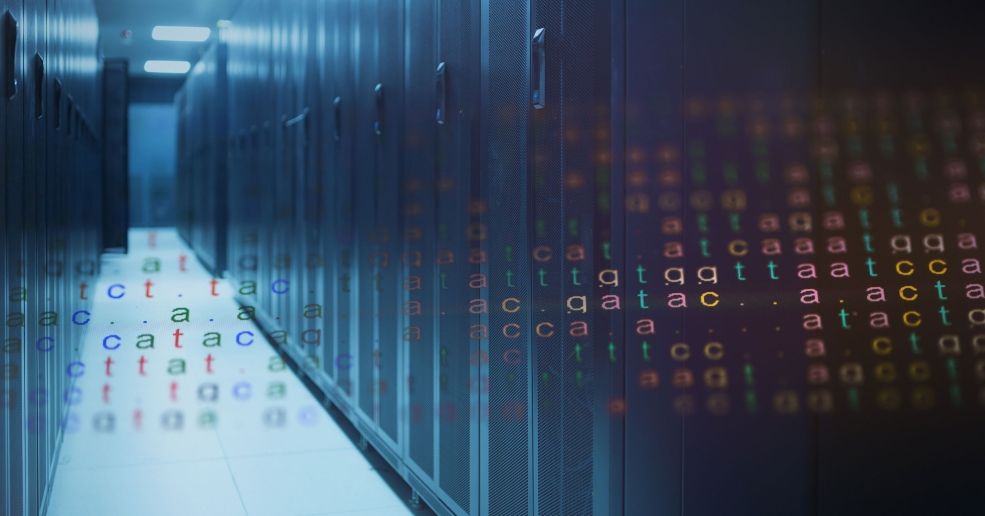
The zettabyte, which corresponds to 1 billion terabytes(1), is a unit used to quantify the volume of digital data generated by the human race each year: in 2025, we are expected to generate 180 zettabytes of data(2). Trying to get your mind around this number might make your head spin, but it also poses a very practical problem: how to store all this data.
Data storage : a challenge for the whole of humanity
In light of this torrent of data, storage infrastructure is faced with three key challenges : physical limits on the density of data that can be stored on a given medium; the costs of maintaining and repairing hardware, which can only increase as the amount of storage grows and technology develops; and the amount of energy consumed by data centres, which in 2020 accounted for around 1% of global electricity consumption. The latest forecasts suggest that this energy consumption is likely to still account for between 1% and 2% of global energy consumption in 2030, notably thanks to progress in the energy arena and constant improvements in equipment and data centres.
However, some analysts expect to see demand for storage media grow much faster than supply. Under this scenario, the available supply of storage media in 2030 would only meet about one third of total demand. Many people still consider it unthinkable to erase data, sometimes for legal reasons but also because it’s entirely possible that doing so could wipe out results that might one day usefully be reanalysed and discoveries waiting to be made. That being the case, what solutions are available to humanity to store all this data?
Biology to the rescue
At the risk of sliding into cliché, one such solution is and always has been inside us : DNA. Nestled deep inside most of our cells, the DNA molecule is life’s information storage medium par excellence.
DNA itself consumes no energy and is remarkably stable when well conserved: the current oldest known sample dates back some 1.5 million years. Moreover, DNA can store large amounts of information in a very small volume. But how would you go about storing a file on a DNA storage medium?
Storing data in DNA : a how-to guide
In practical terms, the information making up a file, currently stored on some medium in the form of zeros and ones(3), would have to be converted into As, Ts, Cs and Gs, the four nucleotides that make up DNA.
This conversion could be done on the basis, for example, that A and T correspond to one (and C and G to zero) or, better still, that each nucleotide corresponds to a combination of two bits, so that A is 00, T is 01, and so on. This would increase the density of information that could be stored.
Producing this synthetic DNA, and then sequencing it to “read” the data stored on it, are now trivial steps whose cost has fallen sharply over the past few years. When the human genome was first sequenced in 2003, the exercise cost $3 billion; sequencing now costs less than $1,000 per genome.
When it comes to storage, the only absolute requirement is that the DNA molecules must be stored in a medium – a capsule, for example – with the least possible humidity. This means the “data” could be left at room temperature for tens of thousands of years or longer without any risk of deterioration.
Isolating data in a capsule in this way imposes one obvious constraint : the data cannot be accessed quickly. As long as this constraint continues to apply, DNA-based storage will only be suitable for “cold” storage, i.e. for storing data that will not need to regularly be read or edited in the medium term. This type of data is nevertheless thought to account for some 60% of existing data – a proportion that’s bound to increase in the future.
An emerging field but with some big customers waiting in line
A number of research organisations and companies are taking an interest in DNA-based storage. In the United States, DARPA(4) and its research counterpart IARPA(5) are running a project aimed at developing new information storage technologies. As part of this project, funding has also been granted to French start-up DNA Script, which is synthesising DNA molecules.
Interested companies include Microsoft as well as Twist Bioscience and Catalog DNA. In Europe, not only Germany and Ireland but also the United Kingdom, home to the European Bioinformatics Institute, are reportedly interested in the subject.
Lastly, in France, as well as DNA Script there is Biomemory, which recently donated two capsules to the national archives containing the 1789 Declaration of the Rights of Man and of the Citizen and the 1791 Declaration of the Rights of Woman and of the Female Citizen.
While this technology fresh out of research labs still has a long way to go, its impact on the precious commodity that is data makes it a deep tech topic to keep a close eye on.
Frédéric Jehl, Deep Tech Analyst, with input from Rabindra Rengaradjalou, Consulting Engineer, Telecoms, IT and Semiconductors
N. B.
(1) One terabyte is enough to store 250 two-hour films or 6.5 million pages of PDF files.
(2) Assuming growth in the volume of digital data averages 23% a year between 2020 and 2025.
(3) Known to us as bits.
(4) Defense Advanced Research Projects Agency
(5) Intelligence Advanced Research Projects Activity












